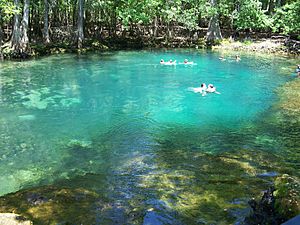Manatee Springs State Park facts for kids
Quick facts for kids Manatee Springs State Park |
|
|---|---|
|
IUCN Category V (Protected Landscape/Seascape)
|
|
| Location | Levy County, Florida, USA |
| Nearest city | Chiefland |
| Governing body | Florida Department of Environmental Protection |
| Designated: | December 1971 |
Manatee Springs State Park is a beautiful Florida State Park. You can find it about six miles west of Chiefland. This park is home to Manatee Spring, which is a very large natural spring. It's called a "first magnitude spring" because it flows out a lot of water.
The spring's water flows directly into the Suwannee River. It creates a short river-like path, which is the longest spring run feeding the Suwannee River. The park also has swamps and hardwood wetlands along the Suwannee. You can also see many sinkhole ponds here. One sinkhole has a cave 90 feet deep. This cave connects to a popular spot for divers called the "catfish hotel."
Contents
History of Manatee Springs
Manatee Springs has a long history. A famous explorer named William Bartram visited it in 1774. He wrote about it in his book, Bartram's Travels. Bartram himself gave the spring its name, "Manate Springs." He saw a manatee that had passed away on the edge of the spring run.
Animals and Plants of the Park
The park is full of different kinds of trees. You can see cypress, sweetgum, maple, and ash trees.
Aquatic Life
Many types of fish live in this part of the Suwannee River. These include Largemouth bass, speckled perch, catfish, and bream. You might also spot longnose gar.
Wildlife on Land
On land, you can see White-tailed deer. There are also various small mammals and birds. These animals live in the park all year long.
Manatees and Vultures
Manatees are very special to this spring. They are seen more often in the fall and winter months. The spring water stays at a constant 72 °F (23 °C). This warm water is a safe haven for manatees. Manatees cannot live long in cold water. So, the spring is a great place for them to have their babies and stay warm in winter.
The spring also attracts many American black vultures. They spend their winters here. The large number of these birds can be quite a sight. They often gather around the moss-draped cypress trees. These vultures are not usually scared of people. They are also not aggressive.
Fun Activities at the Park
There are many fun things to do at Manatee Springs State Park. You can go hiking on trails. Biking is also a popular activity. If you like water, you can go kayaking or canoeing.
Water Activities
You can also enjoy scuba diving, swimming, and snorkeling. It's a great place for wildlife viewing too. The park has a floating dock and a boardwalk. There are eight miles of wooded trails for exploring. You'll also find picnic Pavilions and full camping facilities.
Important Rules for Swimming and Diving
Swimming in the main spring is not allowed in winter. This is when manatees are likely to be resting there. The "catfish hotel" sinkhole is open all year. This spot gives access to some underwater caverns. However, swimming and snorkeling are not allowed in the catfish hotel. This is because of a layer of duckweed on the water.
Certified Open Water divers can dive in the main spring. They can use lights to explore. They can also dive in the catfish hotel cavern without lights. If you are a certified Cavern diver, you can use lights in the catfish hotel cavern. But you should not go beyond the area where daylight reaches. Experienced cave divers can explore several miles of caverns. These caverns feed water into the spring.
Park Hours
The park is open every day. You can visit from 8:00 am until sundown.




